Click on the above“Beginner’s Guide to Vision” to select and add “Star” or “Pin“
Essential knowledge delivered promptly
Essential knowledge delivered promptlyWhat is a Sensor? A sensor is a component or device that converts collected information into signals that can be processed by equipment. Humans act based on information obtained through vision, hearing, smell, and touch, and devices similarly control or process based on information obtained from sensors. The signals (physical quantities) collected and converted by sensors include temperature, light, color, air pressure, magnetic force, speed, acceleration, etc. These utilize changes in semiconductor materials, and there are also biosensors that use biological materials such as enzymes and microorganisms. IoT and Sensors The Internet of Things (IoT) connects all objects to the internet. This includes not only communication devices like smartphones and personal computers but also medical devices, wearables, automotive systems, natural environments, and infrastructure, allowing all objects to connect and share information, thereby creating a more convenient, secure, and safe society. Essential to achieving this is the “sensor” that detects status. [Definitions of IoT-related Terms] IoT: Internet of Things, refers to the state where sensors are embedded in surrounding objects to connect them, enabling communication between objects and between objects and people. Germany’s Industry 4.0: A concept proposed by the German government aimed at enhancing the intelligence level of manufacturing, and a national project jointly promoted by industry, government, and academia. It introduces new concepts aimed at creating new value through factory IoT. M2M: Machine to Machine, refers to direct communication between objects without human mediation.
Geomagnetic Sensor The Earth is surrounded by a magnetic field, known as geomagnetism. A geomagnetic sensor detects the Earth’s magnetic force and is also known as an “electronic compass.” It can detect direction by measuring geomagnetism. 【Geomagnetism around the Earth】
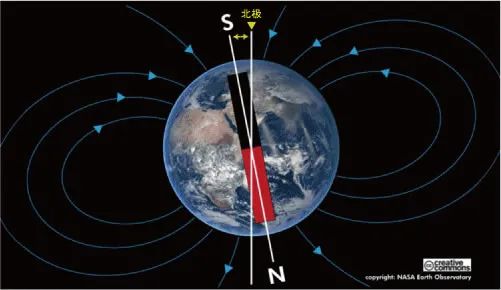
Geomagnetic sensors come in two-axis (X and Y) and three-axis types (adding Z) and measure magnetic force values in each direction. If we disregard inclinations, such as those in simple compasses, we only use the values from the X and Y axes. When considering inclinations, it is necessary to combine the three-axis values of the geomagnetic sensor with those from an accelerometer to correct to the correct direction.
The diagram below shows the distribution of X and Y values when the geomagnetic sensor is rotated horizontally.
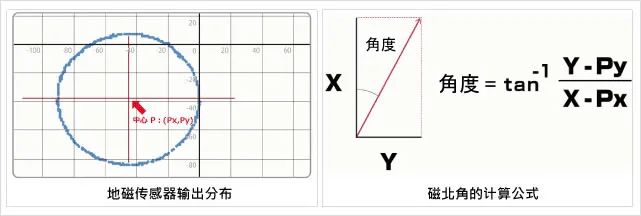
If the geomagnetic sensor rotates horizontally, in an ideal situation without the influence of surrounding magnetic fields, the center of the output distribution would shift to zero.
However, in reality, the center shifts due to environmental magnetic fields, so adjustments are needed to move the center to zero. The north pole derived from the geomagnetic sensor is called magnetic north (slightly deviating from true north). By calculating the angle of this magnetic north using the above equation, the direction can be easily determined. Types of Magnetic Sensors Magnetic sensors are designed to measure the magnitude and direction of magnetic fields. There are various sensors depending on the purpose, and typical sensors are listed below.
| Detection Method | Hall | MR | MI |
| Construction | 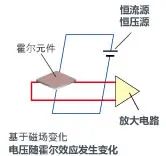 |
 |
 |
| Noise Resistance (Sensitivity) | × | △ | ◎ |
| Current Consumption | × | △ | ◎ |
| Response Speed | × | △ | ◎ |
Hall Sensor
A sensor that measures magnetic flux density based on the Hall effect, outputting a voltage proportional to the magnetic flux density.
It is easy to use and is mainly used in non-contact switch applications, such as detecting the opening and closing of doors and laptops.
MR Sensor
The MR (Magneto Resistance) sensor, also known as a magnetoresistive sensor, measures the magnitude of geomagnetism by utilizing the change in resistance of an object due to a magnetic field.
It has higher sensitivity than Hall sensors and lower power consumption, making it a more widely used magnetic sensor. In addition to geomagnetic detection applications like electronic compasses, it is also used in motor rotation and position detection applications.
MI Sensor
The MI (Magneto Impedance) sensor is a next-generation magnetic sensor that uses special amorphous wire and applies the magneto-impedance effect.
Its sensitivity is over 10,000 times higher than that of Hall sensors, allowing for high-precision measurement of small changes in geomagnetism. It can be applied in ultra-low current consumption orientation detection (electronic compass) and in high-sensitivity applications such as indoor positioning and metal foreign object detection.
Pulse Sensor A pulse wave is the waveform of volume changes in blood vessels caused by the heart sending blood, and the detector that monitors this volume change is called a pulse sensor.
There are four methods to measure heart rate: electrocardiogram, photoplethysmography, blood pressure measurement, and phonocardiography. Among these, photoplethysmography is the method that uses a pulse sensor for measurement.
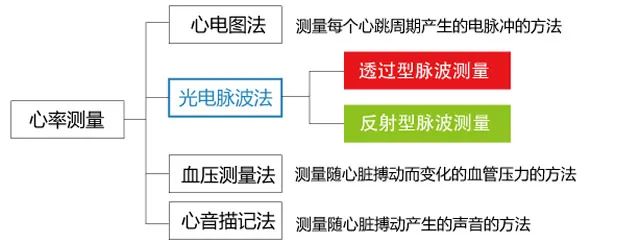
Due to different measurement methods, pulse sensors using photoplethysmography can be either transmission-type or reflection-type. The transmission-type measures the change in blood flow that varies with the heartbeat by illuminating the body surface with infrared or red light, measuring the change in light passing through the body. This method is limited to easily penetrable areas, such as fingertips and earlobes.
Reflection-type Pulse Sensor
The reflection-type pulse sensor illuminates the biological body with infrared light, red light, or green light around 550nm wavelength, using a photodiode or phototransistor to measure the light reflected from the biological body. Oxygenated hemoglobin in arterial blood has the property of absorbing incident light, thus measuring the pulse signal by detecting the change in blood flow (volume change in blood vessels) that varies with the heartbeat over time. Additionally, since it measures reflected light, it is not limited to measurement sites like the transmission-type.
[Principle of Reflection-type Pulse Sensor]

When measuring pulse waves using infrared or red light, the measurement can be affected by infrared light contained in outdoor sunlight, making stable pulse wave measurement difficult. Therefore, it is recommended to use it only for indoor or semi-indoor applications. For outdoor uses like sports watches, the absorption rate of hemoglobin in blood is high, and since green light sources are less affected by ambient light, we use green LEDs as the illuminating light.
Applications of Pulse Sensors Typically, arterial blood oxygen saturation (SpO2) can be measured by observing the following two points. The fluctuation period of the waveform obtained from the pulse sensor is used to observe heart rate (pulse rate); by using two wavelengths of infrared and red light, the pulsation (variation) is observed. Additionally, as applications of pulse sensors, there is an expectation to obtain various vital signs such as HRV analysis (stress levels) and vascular age through high-speed sampling and high-precision measurement.

Barometric Sensor A barometric sensor detects atmospheric pressure. Depending on the pressure value to be measured, there are various sensors made from different materials and methods. Among these pressure sensors, the sensors that detect atmospheric pressure (for barometric detection) are commonly referred to as barometric sensors.
[Materials Used – Pressure Sensors Classified by Method]
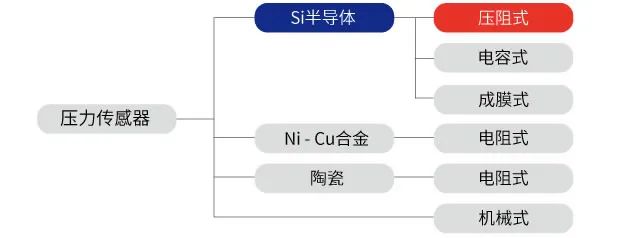
A typical example of a barometric sensor is the piezoresistive type using silicon (Si) semiconductor. The barometric sensor provided by ROHM is also a piezoresistive barometric sensor. Piezoresistive Barometric Sensor The piezoresistive barometric sensor uses a Si single crystal plate as a diaphragm (pressure receiving element), forming a resistance bridge circuit by diffusing impurities on its surface, calculating pressure (barometric pressure) based on the change in resistance value caused by deformation when pressure is applied.
[Piezoresistive Barometric Sensor]
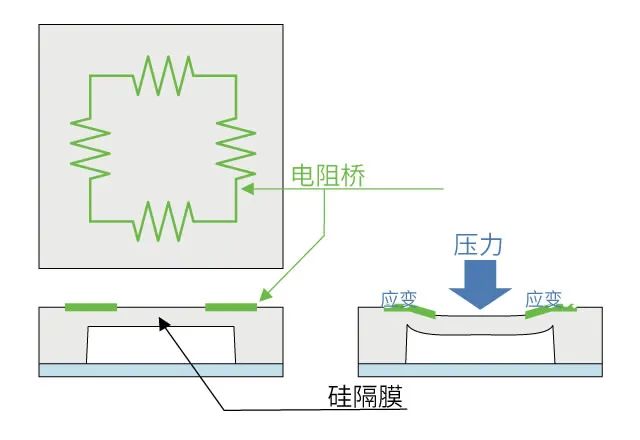
The phenomenon where the resistivity (conductivity) changes due to the pressure applied to the resistance is called the piezoresistive effect. ROHM’s barometric sensor IC integrates a piezoresistive pressure receiving element (diaphragm structure and piezoresistor integrated together ※MEMS), along with temperature correction processing, control circuits, and other integrated circuits (※ASIC) into one package, allowing for easy acquisition of high-precision barometric information.
※ MEMS: Micro Electro Mechanical System, a device that integrates mechanical components, sensors, and actuators (driving components) on a single circuit board.
※ ASIC: Application Specific Integrated Circuit, an integrated circuit that combines multiple circuit functions into one specific application.
Accelerometer Acceleration refers to the speed generated per unit time, and the IC that measures acceleration is called an accelerometer. By measuring acceleration, information about the tilt, vibration, etc., of an object can be obtained. The unit of acceleration is m/s² (※International System of Units SI). Additionally, the unit G is based on standard gravity (1 G = 9.806 65 m/s²). There is also a unit for detecting earthquake vibrations called Gal (CGS unit system).
※ International System of Units SI (French: Système international d’unités) is composed of length m, weight kg, and time s (MKS units).
※ Standard gravity is the acceleration produced by gravity on an object. The increase in speed per unit time of an object in free fall (9.806 65 m/s²).
※ Gal CGS (length cm, weight g, time s as the basis) is the unit of acceleration defined as 1/100 of the SI unit (1 Gal = 0.01 m/s²).
Accelerometers are generally divided into low-G and high-G accelerometers, as shown in the diagram below.
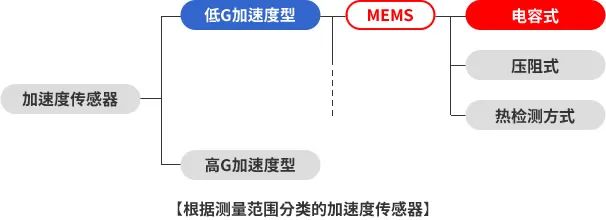
Capacitive Accelerometer
ROHM Group’s accelerometers are capacitive accelerometers using MEMS technology. The sensor element consists of fixed electrodes, movable electrodes, and springs made of Si. In the state without applied acceleration, the distance between the fixed and movable electrodes is the same. When acceleration is applied, the movable electrode shifts. This changes the relationship between the position of the movable electrode and the fixed electrode, resulting in a change in capacitance. The change in capacitance is converted into voltage by the ※ASIC, allowing for the calculation of acceleration.
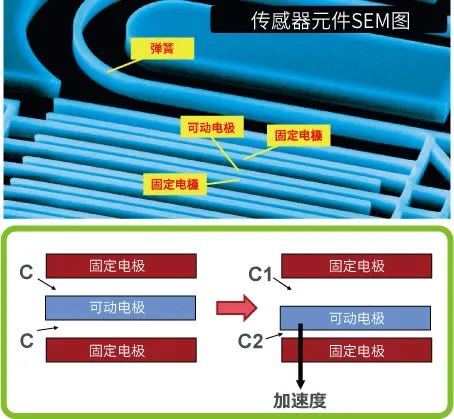
[Capacitive Principle]
※ ASIC Application Specific Integrated Circuit refers to an integrated circuit that integrates multiple circuit functions for specific applications.
Current Sensor What is a current sensor? A current sensor is a device that detects the current flowing in a circuit. Methods of Current Detection are shown in the diagram below, and methods for detecting flowing current can be broadly divided into resistive detection type and magnetic field detection type.
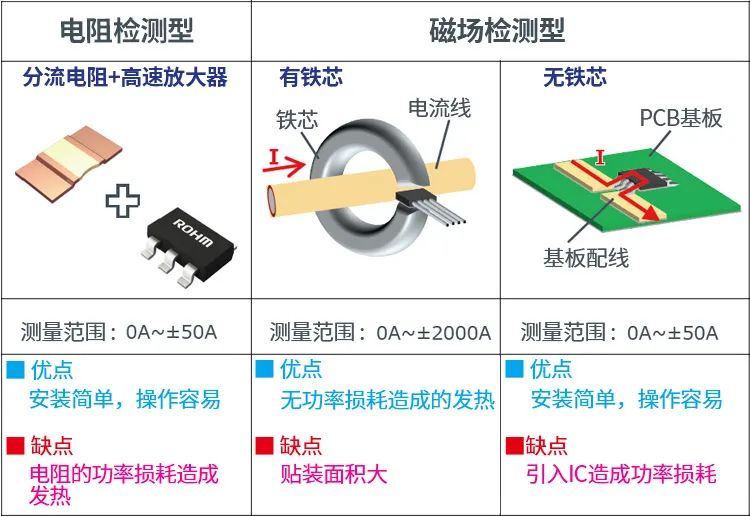
[Current Detection Methods and Characteristics] The resistive detection type converts the voltage drop caused by a shunt resistor into current. It is easy to install and inexpensive, but the downside is that the power loss on the resistor generates significant heat. The magnetic field detection type

[Comparison of Current Sensor Structures (ROHM Survey)] In summary, MI current sensors can perform non-contact current measurement with low power loss and can further reduce mounting area.
Color Sensor Among light-sensitive sensors (photo sensors), those that detect the three primary colors R (red), G (green), and B (blue) are called color sensors. Color sensors receive surrounding light through photodiodes and detect RGB values. Principle of Color Sensors Light with RGB components is illuminated onto an object, and the color components of the reflected light change according to the color of the object. For example, the reflected light component of a red object is red, a yellow object has red and green, and white contains all red, green, and blue components.

[Illustration of Object Reflective Light Color]
Thus, the color of an object is determined by the ratio of the color components (R, G, B) of the light it reflects. The human eye recognizes the color of an object by obtaining the components of reflected light. In complete darkness, nothing can be seen! This is because there is no illuminating light, and naturally, there is no reflected light, making it appear completely dark. Similar to the human eye, color sensors use photodiodes to receive light and recognize colors by calculating the ratio of received R, G, and B amounts. Structure of Color Sensor IC The diagram below shows the structure of a color sensor IC, which includes a color filter and an infrared cut filter.
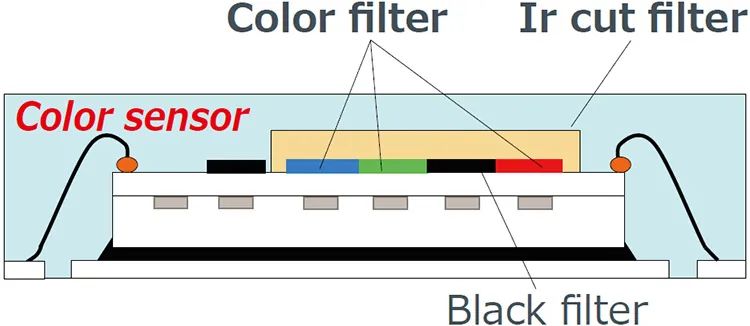
[Brief Structure of ROHM’s Representative Color Sensor]
The following compares the spectral characteristics of sensors with and without these filters.
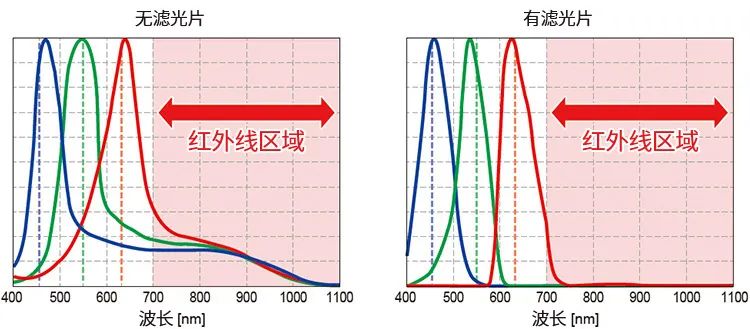
[Illustration of RGB Spectral Characteristics]
Color sensor ICs are equipped with R, G, and B color filters for the internal sensors, providing high RGB spectral characteristics, and by equipping infrared cut filters, they have the ability to remove infrared light, allowing for high-precision color recognition.
This article is for academic sharing only. If there is any infringement, please contact us to delete the article.
Good news! The Beginner's Guide to Vision knowledge group is now open to the public 👇👇👇 Download 1: OpenCV-Contrib Extension Module Chinese Tutorial Reply "Extension Module Chinese Tutorial" in the "Beginner's Guide to Vision" public account backend to download the first Chinese version of the OpenCV extension module tutorial available online, covering installation of extension modules, SFM algorithms, stereo vision, object tracking, biological vision, super-resolution processing, and more than twenty chapters of content. Download 2: Python Vision Practical Project 52 Lectures Reply "Python Vision Practical Project" in the "Beginner's Guide to Vision" public account backend to download 31 practical vision projects including image segmentation, mask detection, lane line detection, vehicle counting, adding eyeliner, license plate recognition, character recognition, emotion detection, text content extraction, facial recognition, etc., to help quickly learn computer vision. Download 3: OpenCV Practical Project 20 Lectures Reply "OpenCV Practical Project 20 Lectures" in the "Beginner's Guide to Vision" public account backend to download 20 practical projects based on OpenCV for advanced learning. Group Chat Welcome to join the public account reader group to exchange with peers. Currently, there are WeChat groups for SLAM, 3D vision, sensors, autonomous driving, computational photography, detection, segmentation, recognition, medical imaging, GAN, algorithm competitions, etc. (these will gradually be subdivided). Please scan the WeChat ID below to join the group, and note: "Nickname + School/Company + Research Direction", for example: "Zhang San + Shanghai Jiao Tong University + Vision SLAM". Please follow the format; otherwise, you will not be approved. After successful addition, you will be invited to the relevant WeChat group based on your research direction. Please do not send advertisements in the group; otherwise, you will be removed. Thank you for your understanding~